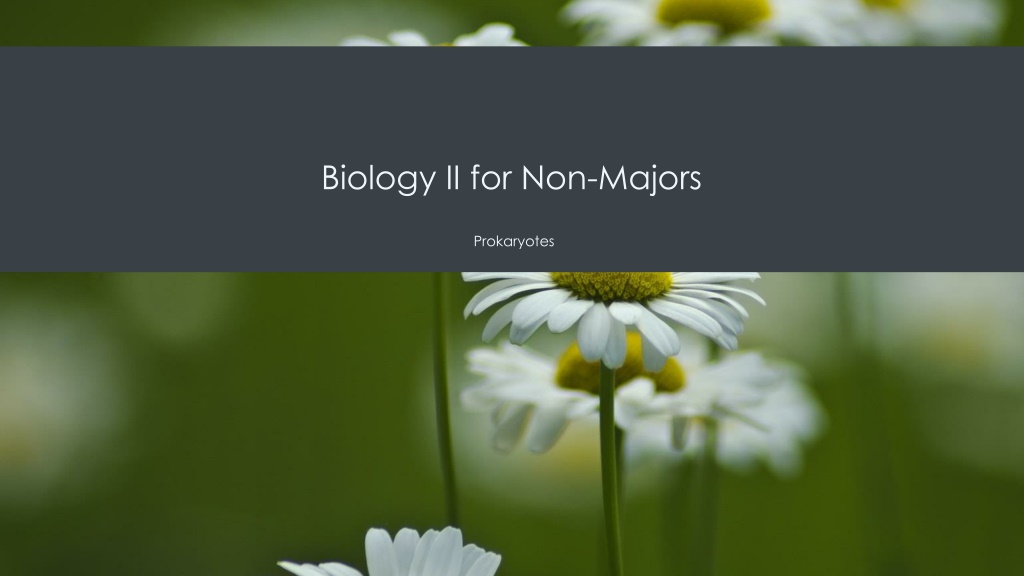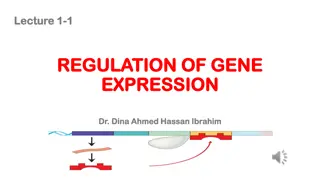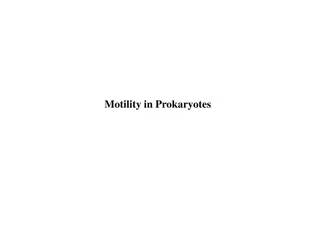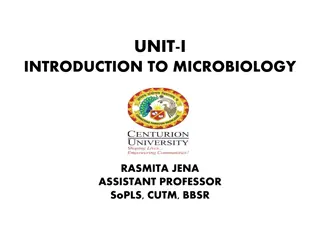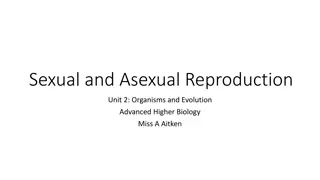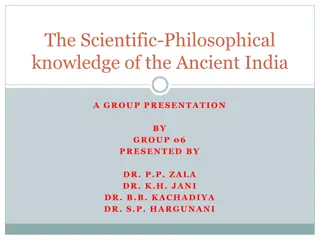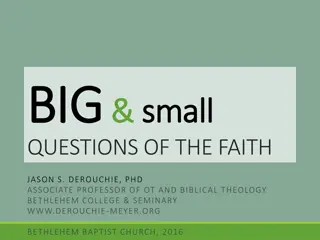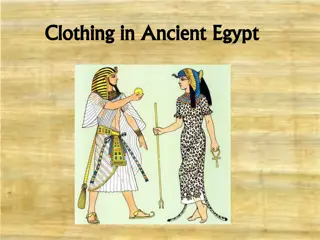Exploring Prokaryotes and Earth's Ancient Life Forms
Uncover the fascinating world of prokaryotes - the earliest inhabitants of Earth dating back billions of years. From microbial mats to stromatolites, delve into the history of life on our planet and the evolution of the atmosphere. Discover how cyanobacteria played a pivotal role in oxygenating the Earth and learn about extremophiles, organisms adapted to thrive in extreme environments.
Download Presentation

Please find below an Image/Link to download the presentation.
The content on the website is provided AS IS for your information and personal use only. It may not be sold, licensed, or shared on other websites without obtaining consent from the author. Download presentation by click this link. If you encounter any issues during the download, it is possible that the publisher has removed the file from their server.
E N D
Presentation Transcript
Biology II for Non-Majors Prokaryotes
Prokaryotes Two of the three domains Bacteria and Archaea are prokaryotic. Prokaryotes were the first inhabitants on Earth, appearing 3.5 to 3.8 billion years ago. These organisms are abundant and ubiquitous; that is, they are present everywhere. In addition to inhabiting moderate environments, they are found in extreme conditions.
Microbial Mats Microbial mats may be the earliest forms of life on Earth, starting about 3.5 billion years ago. A microbial mat is a multi-layered sheet of prokaryotes (Figure 1) that includes mostly bacteria, but also archaea. The first microbial mats were probably at hydrothermal vents.
Stromatolites Fossilized microbial mats are the earliest record of life on Earth. A stromatolite is a sedimentary structure formed when minerals are precipitated out of water by prokaryotes in a microbial mat.
Earths Ancient Atmosphere During the first two billion years of Earth s existence, the atmosphere was anoxic, meaning that there was no molecular oxygen. Therefore, only those organisms that can grow without oxygen anaerobic organisms were able to live. Autotrophic organisms that convert solar energy into chemical energy are called phototrophs, and they appeared within one billion years of the formation of Earth.
Cyanobacteria Cyanobacteria, blue-green algae, evolved from simple phototrophs one billion years later. They began the oxygenation of the atmosphere. Increased atmospheric oxygen allowed the development of more efficient O2-utilizing catabolic pathways. It also opened up the land to increased colonization, because some O2 is converted into O3 (ozone) and ozone effectively absorbs the ultraviolet light that would otherwise cause lethal mutations in DNA.
Extremophiles Some bacteria and archaea are adapted to grow under extreme conditions and are called extremophiles. Radioresistant organisms have adapted to survive high levels of radiation. Deinococcus radiodurans for example has developed DNA repair mechanisms that allow it to reconstruct its chromosome even if it has been broken into hundreds of pieces by radiation or heat.
Preferred Conditions of Extremophiles Conditions for Optimal Growth pH 3 or below pH 9 or above Temperature 60 80 C (140 176 F) Temperature 80 122 C (176 250 F) Temperature of 15 10 C (5 50 F) or lower Salt concentration of at least 0.2 M High sugar concentration Extremophile Type Acidophiles Alkaliphiles Thermophiles Hyperthermophiles Psychrophiles Halophiles Osmophiles
Prokaryote Structure Prokaryotes (domains Archaea and Bacteria) are single-celled organisms lacking a nucleus. They have a single piece of circular DNA in the nucleoid area of the cell. Most prokaryotes have a cell wall that lies outside the boundary of the plasma membrane. Some prokaryotes may have additional structures such as a capsule, flagella, and pili.
Prokaryote Reproduction Reproduction in prokaryotes is asexual and usually takes place by binary fission. Prokaryotes do not undergo mitosis. Rather the chromosome is replicated and the two resulting copies separate from one another due to the growth of the cell. The prokaryote, now enlarged, is pinched inward at its equator and the two resulting cells, which are clones, separate. Binary fission does not provide an opportunity for genetic recombination or genetic diversity, but prokaryotes can share genes by three other mechanisms.
Transformation In transformation, the cell takes up prokaryotic DNA directly from the environment. The DNA may remain separate as plasmid DNA or be incorporated into the host genome.
Transduction In transduction, a bacteriophage injects DNA into the cell that contains a small fragment of DNA from a different prokaryote.
Conjugation In conjugation, DNA is transferred from one cell to another via a mating bridge that connects the two cells after the sex pilus draws the two bacteria close enough to form the bridge.
Bacteria and Archaea Bacteria and Archaea differ in the lipid composition of their cell membranes and the characteristics of the cell wall.
Phospholipid Differences Archaeal phospholipids differ from those found in Bacteria and Eukarya in two ways. First, they have branched phytanyl sidechains instead of linear ones. Second, an ether bond instead of an ester bond connects the lipid to the glycerol. Some archaeal membranes are lipid monolayers instead of bilayers.
Cell Wall Differences The chemical composition of cell walls varies between species. Bacterial cell walls contain peptidoglycan. Archaean cell walls do not have peptidoglycan, but they may have pseudopeptidoglycan, polysaccharides, glycoproteins, or protein-based cell walls.
Groups of Bacteria Bacteria can be divided into two major groups: Gram positive and Gram negative, based on the Gram stain reaction. Gram-positive organisms have a thick cell wall, together with teichoic acids. Gram-negative organisms have a thin cell wall and an outer envelope containing lipopolysaccharides and lipoproteins.
Structural Differences and Similarities between Bacteria and Archaea Structural Characteristic Bacteria Archaea Cell type Prokaryotic Prokaryotic Cell morphology Variable Variable Contains peptidoglycan Does not contain peptidoglycan Cell wall Cell membrane type Lipid bilayer or lipid monolayer Lipid bilayer Plasma membrane lipids Fatty acids Phytanyl groups
Prokaryotic Species Scientists instead classify bacteria and archaea into taxonomic groups based on similarities in appearance, physiology, and genes. The right species concept for these organisms is still a work in progress. Large-scale DNA sequencing makes it possible for scientists to study entire prokaryotic communities in their natural habitat including the many prokaryotes that are unculturable, and would previously have been invisible to researchers.
Metabolism in Prokaryotes For cells to build all of the molecules required to sustain life, they need certain substances, collectively called nutrients. Nutrients that are required in large amounts are called macronutrients, whereas those required in smaller or trace amounts are called micronutrients. Just a handful of elements are considered macronutrients carbon, hydrogen, oxygen, nitrogen, phosphorus, and sulfur.
The Carbon Cycle Prokaryotes play a significant role in continuously moving carbon through the biosphere.
The Nitrogen Cycle Prokaryotes play several key roles in the nitrogen cycle.
Prokaryotic Organisms Cause Numerous Diseases A pandemic is a widespread, usually worldwide, epidemic. An endemic disease is a disease that is constantly present, usually at low incidence, in a population. An emerging disease is one that has appeared in a population for the first time, or that may have existed previously but is rapidly increasing in incidence or geographic range. Approximately 75% of recently emerging infectious diseases affecting humans are zoonotic diseases (zoonoses), or diseases that primarily infect animals and are transmitted to humans
Superbugs An antibiotic is a chemical, produced either by microbes or synthetically, that is hostile to the growth of other organisms. Today s news and media often address concerns about an antibiotic crisis. One of the main causes of resistant bacteria is the abuse of antibiotics. The imprudent and excessive use of antibiotics has resulted in the natural selection of resistant forms of bacteria. The antibiotic kills most of the infecting bacteria, and therefore only the resistant forms remain.
Bioremediation Microbial bioremediation is the use of prokaryotes (or microbial metabolism) to remove pollutants. Bioremediation has been used to remove agricultural chemicals (pesticides, fertilizers) that leach from soil into groundwater and the subsurface. Certain toxic metals and oxides, such as selenium and arsenic compounds, can also be removed from water by bioremediation. One of the most useful and interesting examples of the use of prokaryotes for bioremediation purposes is the cleanup of oil spills.
The Microbiome Microbes help us digest our food, produce crucial nutrients for us, protect us from pathogenic microbes, and help train our immune systems to function correctly. Each individual has a normal microbial flora (also known as a gut microbiota) these terms simply refer to the collective of the bacteria living in each person s stomach. Scientists are also discovering that the absence of certain key microbes from our intestinal tract may set us up for a variety of problems.
Practice Question What impact might antibiotics have on the digestive process?
Quick Review Discuss the diversity of prokaryotic cells Describe the structure of prokaryotic cells Identify the metabolic needs of prokaryotes Identify the role of prokaryotes in biogeochemical cycles Identify the history and current state of bacterial diseases List some benefits of prokaryotes
